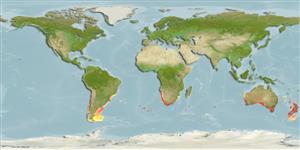Classification / Names
Common names from other countries
Main reference
Size / Weight / Age
Max length : 200 cm SL male/unsexed; (Ref. 3630); common length : 75.0 cm SL male/unsexed; (Ref. 6181); max. published weight: 6.0 kg (Ref. 6181); max. reported age: 10 years (Ref. 28892)
Length at first maturity
Lm ?, range 50 - 60 cm
Environment
Marine; brackish; benthopelagic; oceanodromous; depth range 0 - 550 m (Ref. 6390), usually 100 - 500 m (Ref. 6181)
Climate / Range
Subtropical; 13°C - 18°C (Ref. 6181), preferred 15°C (Ref. 107945); 21°S - 56°S, 75°W - 177°E (Ref. 54924)
Distribution
Southwest Atlantic: Uruguay, Argentina and Tierra del Fuego. Eastern Atlantic: Tristan da Cunha and South Africa. Western Indian Ocean: South Africa and the St. Paul and Amsterdam islands. Eastern Indian Ocean: Tasmania and southern coast of Australia. Southwest Pacific: New Zealand and southern coast of Australia. Southeast Pacific: southern Peru, Chile, and Tierra del Fuego.
Countries | FAO areas | Ecosystems | Occurrences | Introductions
Short description
Dorsal
spines
(total): 19 - 21;
Dorsal
soft rays
(total): 113;
Anal
spines: 1;
Anal
soft rays: 10 - 12;
Vertebrae: 35. Body elongate and strongly compressed. Lateral line single, running close to the upper contour of the body below most of the first dorsal-fin base then abruptly curving ventrally. Body is dark blue, slightly paler on belly; first dorsal fin membrane black (Ref. 6181).
IUCN Red List Status (Ref. 115185)
Threat to humans
Harmless
Human uses
Fisheries: highly commercial; gamefish: yes
Tools
Special reports
Download XML
Internet sources
Estimates of some properties based on models
Phylogenetic diversity index
PD50 = 1.0000 many relatives (e.g. carps) 0.5 - 2.0 few relatives (e.g. lungfishes)
Trophic Level
3.6 ±0.3 se; Based on diet studies.
Resilience
Medium, minimum population doubling time 1.4 - 4.4 years (tm=2-4; tmax=10)
Vulnerability
High vulnerability (63 of 100)
Price category
